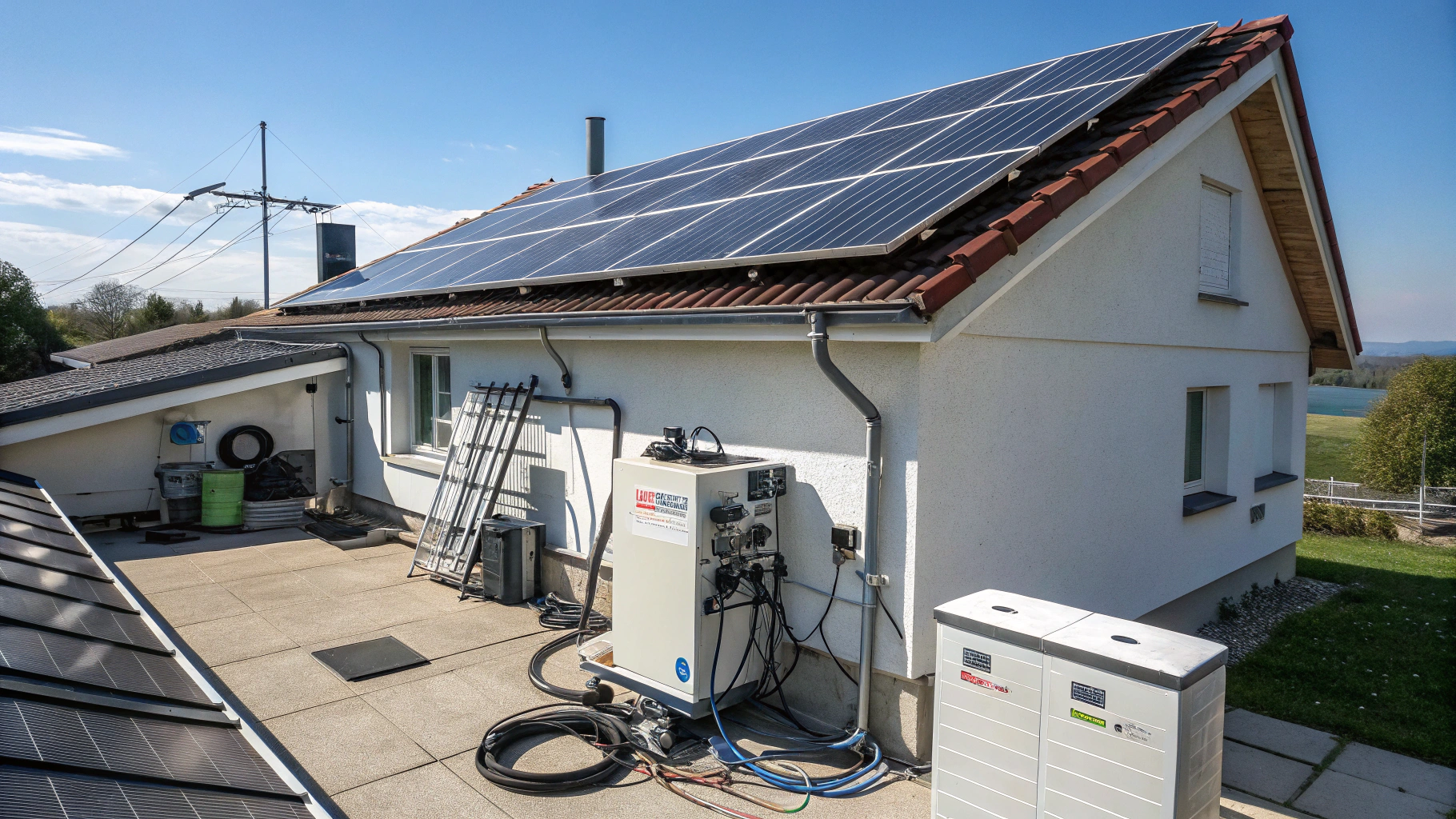
When I first pondered the notion of embracing off-grid living, the sheer magnitude of relying exclusively on a solar power system felt overwhelming. The allure of liberating myself from the traditional electricity grid was captivating, yet it left me grappling with a myriad of questions: What precisely constitutes such a system? How does it operate harmoniously to energize a household? My quest for clarity propelled me deeper into the realm of these innovative self-sustaining energy solutions.
The enchantment of this endeavor begins with its fundamental components: solar panels, a charge controller, batteries, and an inverter. Each element plays an indispensable role in fostering a reliable power supply. Solar panels dutifully harvest energy from the sun, while the charge controller ensures that the batteries don’t become overcharged. This stored energy is then transformed by the inverter, rendering it ready to energize the devices within my home. Discovering these intricacies not only bolstered my confidence in this endeavor but also sparked an eager desire to integrate this sustainable solution into my life.
The advantages of off-grid living are manifold, ranging from freedom from power outages to an unwavering commitment to environmental sustainability. The autonomy gained from not being tethered to grid electricity is nothing short of revolutionary. If you resonate with my appreciation for both independence and green energy, embarking on the exploration of off-grid systems could very well be a transformative expedition. I wholeheartedly encourage you to consider this route and relish the myriad rewards it offers.
Fully grasping the components and mechanisms of an off-grid solar power system unveils a pathway to self-sufficiency and sustainability—a tantalizing alternative to the conventional dependence on grid electricity.
An off-grid solar power system relies solely on wind energy.False
This statement is false; it primarily uses solar energy from sun.
Solar panels are essential components of an off-grid system.True
This statement is true; solar panels harvest energy for the system.
What is an Off-Grid Solar Power System?
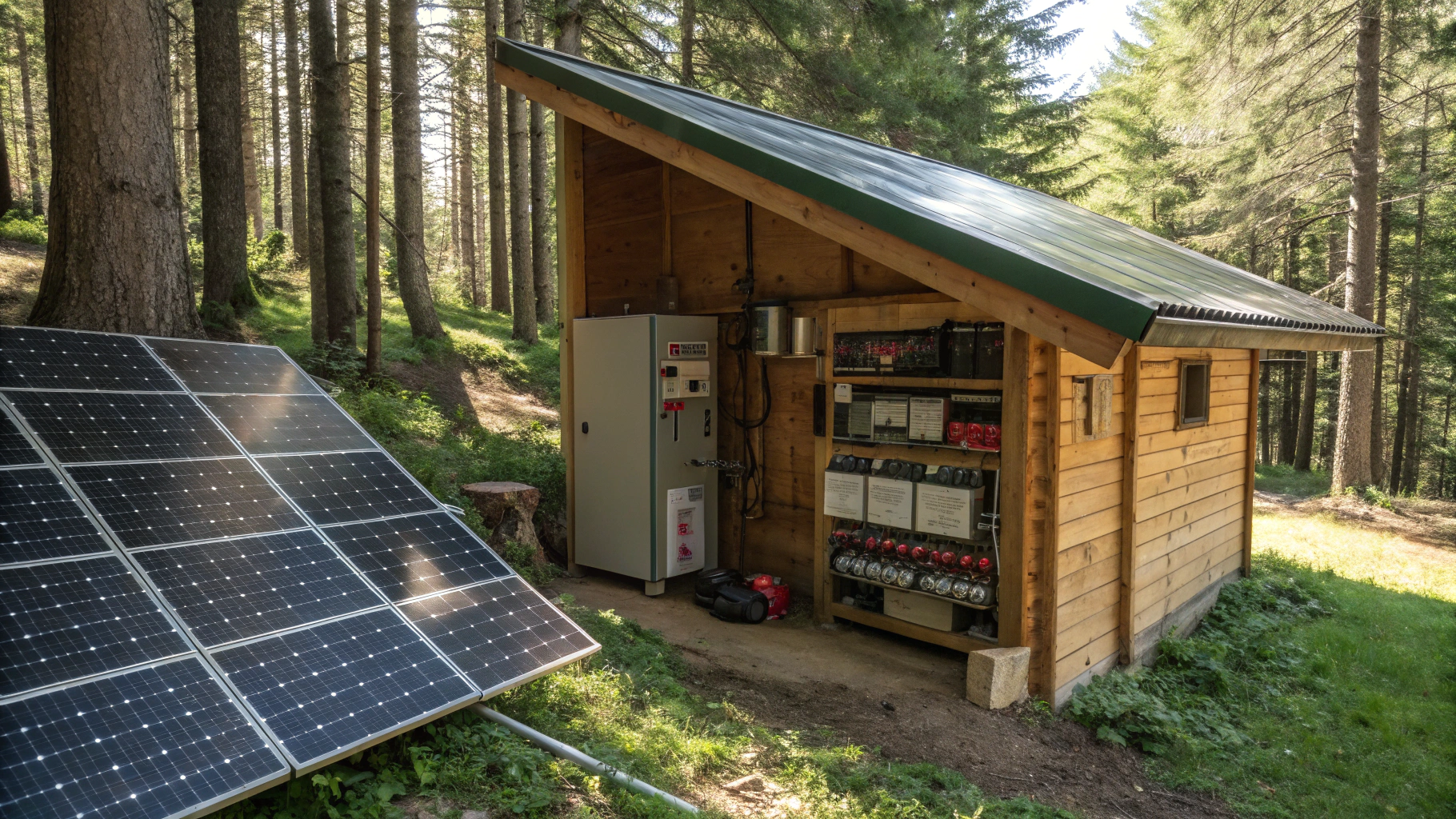
As I took my initial strides into the realm of self-sufficient energy for my secluded woodland retreat, I stumbled upon a fascinating universe brimming with potential—off-grid solar power systems. At first, I felt ensnared by an avalanche of possibilities. Untangling the intricate components and underlying principles often felt akin to mastering a foreign tongue. Yet, through a blend of experimentation, diligent research, and a hearty dose of inquisitiveness, I gradually grasped the essentials of creating a sustainable energy framework, completely divorced from the conventional electrical grid.
An off-grid solar power system constitutes a self-sufficient energy arrangement where solar panels, charge controllers, battery banks, and inverters coalesce, playing pivotal roles. Each component interconnects seamlessly—solar panels harvest sunlight, charge controllers balance voltage, battery banks store the conserved energy, and inverters convert it into a form suitable for household devices. This level of independence not only fulfilled my desires for remote living but also presented an eco-friendly energy alternative.
To distill the essence: Off-grid solar power systems ingeniously deploy solar panels, charge controllers, and battery banks to produce, oversee, and store energy for autonomous utilization, adeptly transforming sunlight into accessible power.
Should the prospect of detaching from conventional energy sources intrigue you, I wholeheartedly urge you to delve deeper into these systems. It’s far more than a mere means of energy; it symbolizes a venture toward self-sufficiency and a heightened awareness of our environmental impact. As you contemplate your options, ensure they resonate with your energy requirements and lifestyle choices. May this serve as a valuable compass in your journey toward sustainable living.
Understanding Off-Grid Solar Power Systems: A Path to Energy Independence
What if I told you that you could harness the sun’s energy without relying on the traditional electrical grid? My journey into off-grid solar power systems began as an exploration of self-sustained energy for my remote woodland retreat. Over time, I learned how these systems uniquely combine solar panels, charge controllers, battery banks, and inverters to create an independent energy solution, which not only aligns with my desire for autonomy but also champions eco-friendliness in energy consumption. In essence, off-grid solar power systems transform sunlight into usable energy while supporting a sustainable lifestyle.
| Component | Function |
|---|---|
| Solar Panels | Harvest sunlight and convert it into electricity. |
| Charge Controllers | Regulate voltage to ensure batteries are charged appropriately. |
| Battery Banks | Store the harvested energy for later use. |
| Inverters | Convert stored energy into a usable format for household devices. |
An off-grid solar power system relies entirely on the electrical grid.False
This is false; off-grid systems operate independently from the grid.
Solar panels are a crucial component of off-grid solar power systems.True
This is true; they are essential for capturing sunlight for energy.
Definition and Key Concepts
Within the scholarly domain, grasping the essence of definitions is crucial. A meticulous “definition” acts as the bedrock for clarifying pivotal concepts throughout diverse fields. Yet, what exactly constitutes a “definition”? It encapsulates core ideas, illuminating intricate notions. The importance of definitions in academia is profound, as they delineate essential terms, offering both practical and theoretical frameworks. Exploring the nuances of key concepts fosters a richer comprehension, empowering the expression of foundational ideas and differentiating theoretical constructs. Consequently, articulating key concepts is vital for academic lucidity.
Self-Sustainability of Off-Grid Systems
Off-grid systems epitomize the quintessence of self-sufficiency, seamlessly intertwining solar and wind energy to forge autonomous power networks. These eco-centric solutions advocate for renewable energy, showcasing a commitment to sustainability. By enhancing energy efficiency, homes that embrace self-reliance truly reflect the principles of sustainable living. Furthermore, off-grid solar and storage innovations bolster energy independence, while green technology unearths alternative energy avenues for remote locales. This transformative shift transcends mere backup power frameworks, heralding a new era of off-grid existence that exemplifies energy autonomy through inventive sources. Ultimately, sustainable living flourishes within the embrace of off-grid systems.
Global Growth Trends and Market Share
In 2023, the world economy embarks on an extraordinary journey of expansion, fueled by the vigorous ascent of emerging markets and groundbreaking business strategies transcending borders. Analyzing market shares unveils a tapestry of shifting competitive dynamics, accentuating the necessity of grasping sectoral growth trajectories. An extensive global market evaluation highlights robust economic trends that resonate with the cadence of increasing globalization. Market share insights reveal tantalizing prospects for foreign market infiltration. The intricate landscape of global business strategies hints at transformative industry growth patterns, urging a proactive exploration of contemporary market share forecasts. Embrace these expansive growth trends to capture competitive leverage.
What Are the Components of an Off-Grid Solar System?
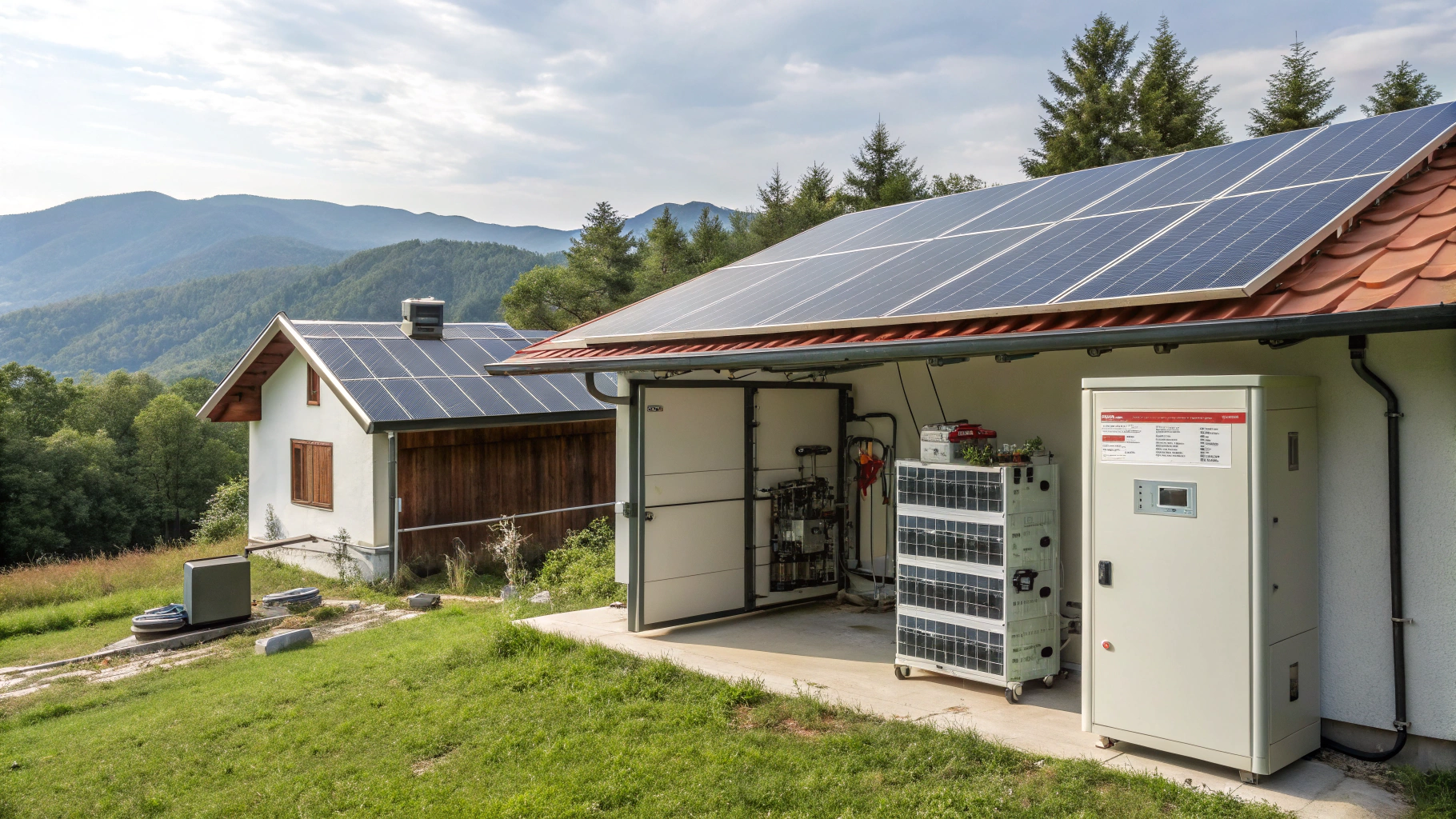
The prospect of transitioning to an independent energy solution first crossed my mind amidst a mix of trepidation and fascination. The notion of embracing an off-grid solar power system, which empowers me to harness the sun’s energy free from the constraints of conventional grids, is not just liberating; it’s downright enticing. If you’ve ever been captivated by the idea of off-grid living, rest assured that you’re not alone in this contemplation. Many embark on this journey, drawn not only by the environmental perks but also by the remarkable independence it affords.
As I delved deeper into the realm of off-grid solar solutions, I unearthed essential components that constitute such a system: solar panels, a solar charge controller, an off-grid inverter, and solar batteries. Each of these pieces plays an integral role in the ecosystem. Grasping their individual functions and discerning the best varieties can spell the difference between a flourishing system and one that falters.
To those on the verge of this significant leap, let me offer a word of reassurance: the right components are critical. When selecting solar panels—be it mono-crystalline or poly-crystalline—your choice is crucial. The decision to go for MPPT or PWM charge controllers can markedly influence your system’s efficiency and longevity. Additionally, opting for the right deep-cycle or lithium-iron-phosphate batteries and matching them with an appropriate inverter is essential to ensuring your energy demands are satisfactorily fulfilled.
For anyone eager to adopt this sustainable lifestyle, I encourage you to dig deep into the specifics of each component. Explore the nuances of solar charge controllers, and consider how MPPT might be better suited to your requirements. Moreover, don’t overlook the significance of a well-proportioned inverter in your overall setup. Believe me, the effort you invest will prove invaluable.
An off-grid solar power system frees you from the shackles of traditional electricity sources, utilizing renewable solar energy through expertly chosen solar panels, charge controllers, inverters, and batteries to forge a path towards sustainable independence. If my excitement for this venture resonates with you, it may just be the perfect moment to take that bold step forward. Begin your exploration of these vital components and embark on your journey toward energy self-sufficiency today.
The Essential Elements of an Off-Grid Solar Power System
An off-grid solar power system frees you from the shackles of traditional electricity sources, utilizing renewable solar energy through expertly chosen solar panels, charge controllers, inverters, and batteries to forge a path towards sustainable independence.
| Component | Function | Types | Considerations |
|---|---|---|---|
| Solar Panels | Convert sunlight into electricity | Mono-crystalline, Poly-crystalline | Efficiency ratings, space requirements |
| Solar Charge Controller | Regulate battery charging | MPPT, PWM | System efficiency, battery life |
| Off-Grid Inverter | Convert DC to AC power | Pure sine wave, Modified sine wave | Power requirements, compatibility |
| Solar Batteries | Store energy for later use | Deep-cycle, Lithium-ion | Discharge rates, lifespan, cost |
Off-grid solar power systems rely solely on traditional electricity sources.False
This statement is false; off-grid systems harness solar energy, not traditional sources.
Choosing the right solar panels enhances the efficiency of off-grid systems.True
This statement is true; selecting the right panels is crucial for system performance.
Solar Panels: The Core Component
Solar panels serve as a cornerstone in the quest for sustainable energy, seamlessly integrating solar energy into modern solutions. A diverse array exists—spanning from photovoltaic to residential systems—highlighting the necessity of grasping their operational intricacies and installation nuances. Homeowners can reap a plethora of benefits, including cost reductions and enhanced efficiency. The solar technology landscape continues to flourish, driven by innovative companies committed to making renewable energy accessible. Remarkably, the upkeep of solar panels is minimal, augmenting the lifespan of these electric systems. Staying informed on solar energy trends is essential to maximizing the advantages they offer, paving the way for a greener future.
Battery Storage: Ensuring Power Availability
Battery storage is revolutionizing energy management paradigms, presenting unmatched power accessibility through cutting-edge battery innovations. Home and solar battery systems epitomize autonomy in energy, harmoniously integrating with distributed resources for a greener future. Lithium-ion batteries, celebrated for their efficacy, remain pivotal in the realm of renewable energy storage, fostering resilience. Furthermore, off-grid storage, in concert with grid solutions and backup systems, yields economical battery strategies. These breakthroughs in energy storage frameworks are integral to cultivating sustainability, encapsulating the quintessence of modern energy management.
Charge Controllers and Inverters: Managing Power
Within the domain of renewable energy paradigms, charge controllers and inverters are instrumental in orchestrating solar power utilization. Charge controllers, encompassing both solar and battery variants, meticulously regulate energy influx into storage systems, thereby amplifying overall efficiency. Conversely, inverters—most notably, the DC to AC types—transform captured solar energy into consumable electricity. Diverse inverter classifications, such as grid-tied and off-grid models, address specialized power distribution requirements. The efficacy of charge controllers and hybrid inverters is paramount for optimal solar energy governance, establishing dependable energy frameworks. Highlighting the nuances of inverter types and voltage regulators can profoundly elevate electric power management.
How Do Off-Grid Solar Systems Work?
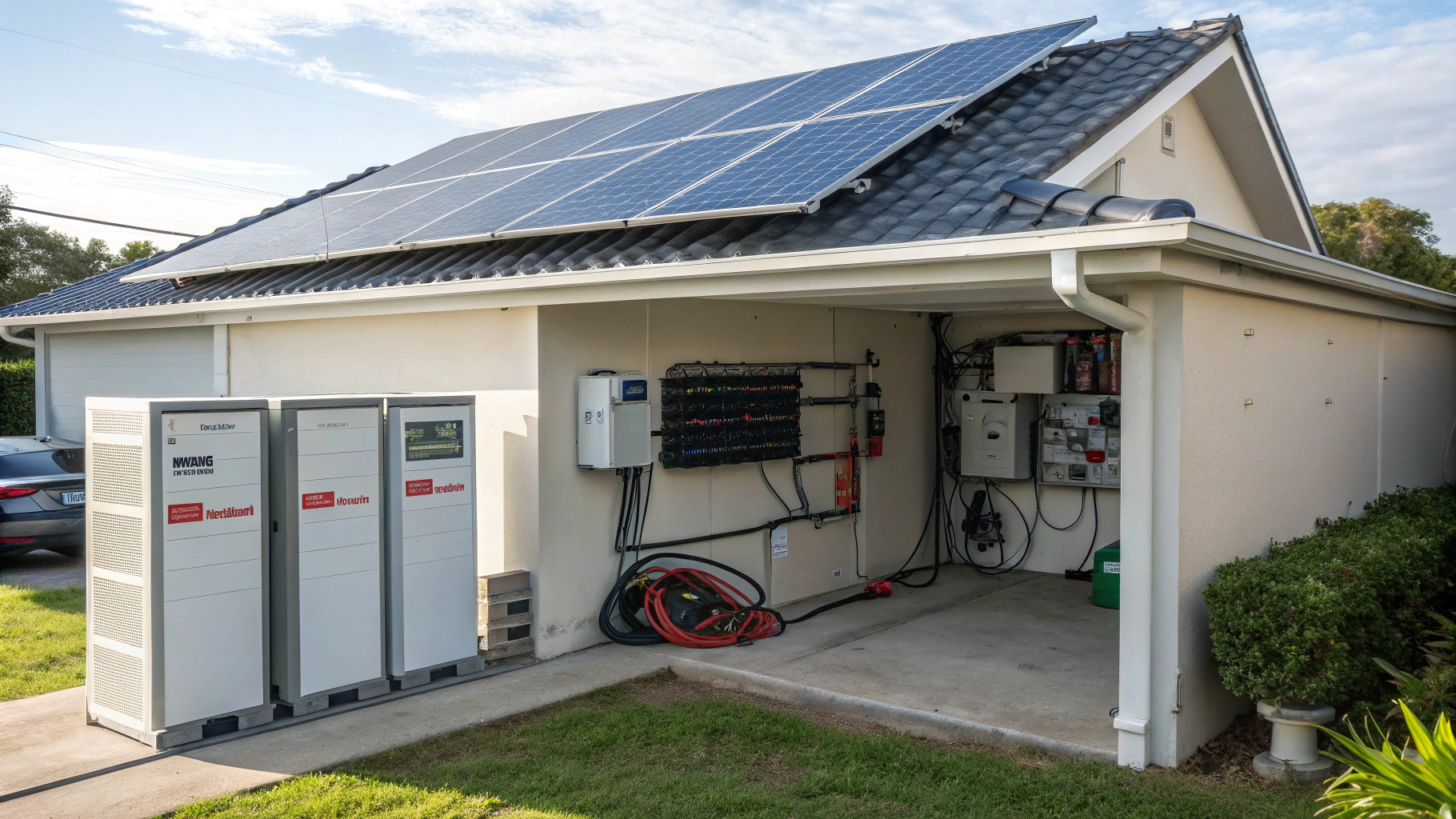
Reflecting on my initial foray into the realm of off-grid living, I found myself engulfed by the myriad of choices and intricate components integral to establishing a self-sufficient solar system. The alluring prospect of powering my home independently was equally captivating and intimidating. I found myself grappling with essential questions: How do these systems function in practice? Which components are indispensable, and what justifies my choice of this approach over a traditional grid-connected system?
An off-grid solar system operates distinctly from its grid-tied equivalent; it harnesses and secures energy during daylight hours through a harmonious blend of solar panels, a charge controller, a battery bank, and an inverter. This configuration ensures that I can still access stored solar energy during the night or on overcast days. Each element plays a pivotal role: solar panels absorb sunlight and convert it into electricity, the charge controller oversees the flow of power into the battery bank, which safely retains the energy, while the inverter transforms it into usable electricity for everyday household appliances. Grasping the nuances of this arrangement was instrumental in recognizing both the enticing freedoms and the inherent limitations—such as elevated initial investments and ongoing maintenance—associated with off-grid living.
At the heart of an off-grid solar power system is its remarkable ability to autonomously generate, store, and employ solar energy, rendering it an exceptional solution for isolated locations or regions lacking dependable grid connectivity. Once I began to demystify these concepts, the myriad advantages came into sharp focus, empowering me to make enlightened choices about my energy consumption. If you find yourself intrigued by this topic, I wholeheartedly invite you to delve deeper into the possibilities while contemplating your personal circumstances. Whether you seek energy independence or harbor specific off-grid dreams, this exploration could very well prove to be rewarding.
Understanding the Mechanics of Off-Grid Solar Systems
Reflecting on my journey into off-grid living, I discovered how off-grid solar systems uniquely operate compared to grid-tied ones. They effectively generate, store, and utilize solar energy, which is crucial for achieving energy independence. Through this experience, I learned that managing components like solar panels, charge controllers, batteries, and inverters is essential for maximizing energy efficiency.
| Component | Function |
|---|---|
| Solar Panels | Convert sunlight to electricity |
| Charge Controller | Regulates power flow to batteries |
| Battery Bank | Stores generated energy |
| Inverter | Converts stored energy for household use |
An off-grid solar system does not store energy for use at night.False
Off-grid systems store energy in batteries for nighttime usage.
Solar panels are essential for converting sunlight into electricity.True
Solar panels absorb sunlight, converting it into usable electrical energy.
The Flow of Energy: From Sun to Battery
The odyssey of solar energy, traversing from the celestial sun to sophisticated solar battery systems, epitomizes the wonders of contemporary science. It commences with photovoltaic cells that ingeniously transmute sunlight into electricity. This intricate energy cascade is refined through solar panels paired with cutting-edge battery innovations, facilitating seamless clean energy transmission. Under the unwavering influence of gravitational forces, solar applications flourish across diverse domains. The advantages—prolonged battery longevity, enhanced energy efficiency, and renewable frameworks—highlight sustainable energy technology as a pivotal green solution for tomorrow’s world.
Role of Charge Controllers and Inverters
Within the domain of sustainable energy strategies, the influence of charge controllers and inverters is paramount. Charge controllers, encompassing PWM and MPPT varieties, adeptly manage battery systems in off-grid solar configurations, thereby maximizing solar energy utilization. Concurrently, inverters execute a pivotal function in energy conversion, metamorphosing direct current into alternating current. Integral to electrical engineering, these systems—ranging from solar to hybrid inverters—amplify solar energy oversight. Their vital role in renewable energy applications underscores the necessity of comprehending these elements for the pursuit of efficient energy solutions that foster sustainable futures.
Power Management and Consumption
In the context of an ever-accelerating technological milieu, mastering power management emerges as an imperative. As energy demands escalate, sophisticated strategies for power efficiency become essential. Central to this endeavor, energy management systems facilitate the optimization of power consumption, harnessing cutting-edge technologies such as intelligent power regulation to promote sustainable practices. By integrating innovative electrical management with conservation methodologies, we can realize marked reductions in waste. Furthermore, the synergy of renewable energy oversight with consumption monitoring and demand-response tactics yields formidable solutions for enhanced efficiency, benefitting both residential and industrial sectors in paving the way for an eco-friendlier future.
How to Install an Off-Grid Solar System?

When I made the pivotal choice to break free from the conventional energy grid and venture into the world of an off-grid solar power system, a whirlwind of emotions washed over me—exhilaration intertwined with a hint of anxiety. This move represented a monumental leap toward achieving energy independence and committing to a sustainable way of life, yet the intricacies of the endeavor loomed large before me. Nevertheless, as I immersed myself in the essential elements—solar panels, a charge controller, a battery bank, and an inverter—I uncovered the roadmap that would lead me to success.
Picture this: awakening to a sun-drenched morning where your home flourishes solely on the clean energy captured from the sun’s rays. This is the vision I hope to ignite within you. Solar panels, thoughtfully positioned to catch sunlight at the ideal angle, serve as the gateway, transforming luminous rays into usable electricity. The charge controller plays a crucial role in regulating the flow of energy to your battery bank, ensuring it receives a balanced infusion of power, thereby avoiding overcharging and enhancing the longevity of your batteries.
Once your battery bank bursts into life, the inverter takes center stage, converting the stored DC power into AC power that’s compatible with the myriad of devices we rely on daily. It’s imperative to connect these elements in a harmonious sequence while prioritizing safety to ensure seamless operation. Additionally, routine upkeep—such as scrubbing the solar panels and monitoring battery electrolyte levels—forms the backbone of your system’s sustained performance.
Embarking on the installation of an off-grid solar power system encompasses selecting the appropriate solar panels, configuring a reliable charge controller, establishing a robust battery bank, and opting for a fitting inverter—all while ensuring safe connections and committing to regular maintenance. This journey toward energy autonomy transcends mere eco-enthusiasm; it beckons anyone willing to champion a sustainable tomorrow. May this spark your curiosity and inspire you to take bold strides in crafting your own off-grid solar kingdom.
Essential Steps to Set Up Your Off-Grid Solar System
As I took the leap into the realm of off-grid solar power, I discovered the process involves the integration of solar panels, a charge controller, a battery bank, and an inverter, allowing me to harness the sun’s energy effectively. This not only grants energy independence but also supports sustainable living. Successfully installing an off-grid solar system requires careful selection and configuration of essential components while ensuring safety and maintenance practices are followed.
| Component | Function | Importance |
|---|---|---|
| Solar Panels | Capture sunlight and convert it into electricity | Essential for energy generation |
| Charge Controller | Regulates energy flow to the battery bank | Prevents overcharging and extends battery life |
| Battery Bank | Stores energy for later use | Enables energy independence |
| Inverter | Converts DC into AC power | Allows compatibility with household devices |
Installing an off-grid solar power system requires no maintenance.False
Routine upkeep is essential for the system’s sustained performance.
A charge controller regulates energy flow to the battery bank.True
The charge controller ensures balanced power infusion to prevent overcharging.
Step-by-Step Installation Guide
In the intricate domain of software deployment, a meticulously designed installation guide is indispensable. This elaborate instructional compendium meticulously outlines the installation journey, blending straightforward steps with insightful tips to facilitate a flawless execution. Whether you’re navigating a self-service guide or unraveling a user manual, these thorough directives shed light on the precise art of software installation. Should complications arise, our troubleshooting segment delivers tactical resolutions. Immerse yourself in this succinct installation guide, transforming convoluted configurations into a breeze. Your journey to successful system installation commences now.
Important Safety Considerations
In our increasingly frenetic age, the importance of safety consciousness cannot be overstated. Regardless of whether one is at home or in a professional setting, following essential safety protocols is indispensable for protecting well-being. It is critical to cultivate personal safety practices and grasp emergency response strategies. Families must heed child safety advice, while those venturing outdoors should remain vigilant. By cultivating meticulous workplace safety measures and embracing health-conscious practices, we can significantly mitigate risks. Upholding stringent safety standards transforms this endeavor into an enriching lifestyle rather than mere protocol—prioritize safety today for a secure tomorrow.
Maintenance Tips for Optimal Performance
Optimizing machinery performance hinges on perceptive maintenance methodologies. By embracing an all-encompassing maintenance framework, one can significantly enhance operational efficacy and performance refinement. Integral to this pursuit are both routine maintenance and proactive measures aimed at ensuring peak functionality. Empower your maintenance crew with a practical checklist and essential troubleshooting insights. Best practices, anchored in a meticulously structured maintenance timetable, bolster equipment efficacy. Consequently, the strategic orchestration of maintenance initiatives is paramount for achieving enduring operational brilliance and substantial performance advancements.
What Are the Benefits of Off-Grid Solar Energy?
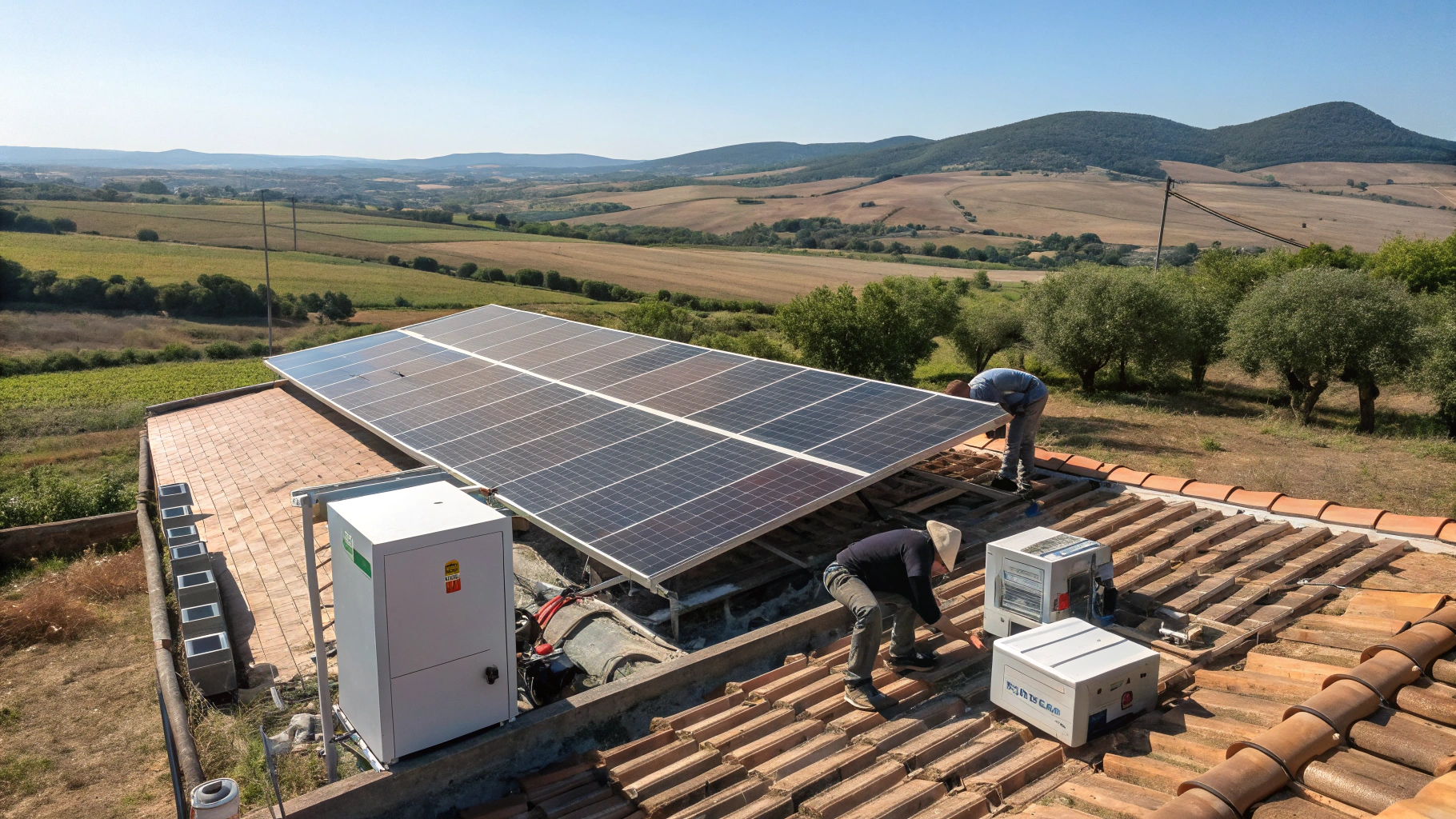
The moment I first encountered the notion of an off-grid solar power system, an exhilarating wave of curiosity washed over me. Could it really be possible to live autonomously, completely liberated from the confines of the electrical grid? This question lingered in my mind, igniting a quest for understanding how this innovative system could pave the way for energy independence. Off-grid solar power transcends mere technological advancement; it embodies a transformative lifestyle choice aimed at self-sustainability. Imagine the freedom of powering your home in a remote area, liberated from utility bills and unaffected by the unpredictability of grid failures—this is not just a dream, but a tangible reality, with benefits extending far beyond simple cost reductions.
Delving into the myriad advantages of off-grid solar systems revealed their versatility, particularly for those residing in isolated locales. The empowerment derived from detaching oneself from the conventional grid is especially significant for individuals in rural regions where access to it is at best sporadic. By adopting an off-grid solution, one not only slashes energy expenses but also plays a crucial role in fostering environmental sustainability by reducing one’s carbon footprint.
The environmental merits of off-grid solar systems are profound—they operate without any fossil fuel dependency and generate zero emissions during electricity production. This commitment to sustainability resonates deeply with me, as I have long been an advocate for green living.
For anyone contemplating this shift, the benefits are evidently compelling: autonomy, sustainability, and financial prudence. If you’re on the lookout for energy independence through off-grid solar solutions, rest assured that the perks also encompass diminishing reliance on traditional energy sources and aiding in the creation of a cleaner, greener planet.
I sincerely hope that sharing these reflections inspires you to dive deeper into the fascinating world of off-grid solar energy. Why wait? Begin your exploration today and discover how these systems can facilitate your quest for energy autonomy while contributing to a sustainable future!
Exploring the Transformative Benefits of Off-Grid Solar Energy
The environmental merits of off-grid solar systems are profound—they operate without any fossil fuel dependency and generate zero emissions during electricity production. By embracing off-grid solar solutions, I experienced an exhilarating sense of autonomy, turning energy independence into a tangible reality. Not only does this shift empower individuals in remote locations, but it also fosters a commitment to sustainability.
| Benefit | Description |
|---|---|
| Energy Independence | Live autonomously without reliance on the electrical grid. |
| Cost Savings | Reduce energy expenses and eliminate utility bills. |
| Environmental Sustainability | Generate zero emissions and reduce carbon footprint. |
| Flexibility | Adaptable to homes in remote areas with limited grid access. |
| Community Impact | Contribute to a cleaner planet and promote green living. |
Off-grid solar systems rely heavily on fossil fuels for energy.False
This statement is false; off-grid solar systems are fossil fuel-free.
Off-grid solar systems help reduce reliance on traditional energy sources.True
This statement is true; they promote sustainability and energy independence.
Energy Independence and Reliability
In the current tumultuous geopolitical landscape, achieving energy independence transcends mere advantage, evolving into an unequivocal necessity. The adoption of renewable energy sources not only strengthens energy security but also invigorates sustainable solutions. Countries leveraging alternative energies amplify grid dependability, forging a path towards autonomy and self-sufficiency. Thoughtful energy policies, anchored in diversification and transition, enhance resilience. Initiatives in clean energy, coupled with meticulous management, render the dream of national energy independence palpable. Ultimately, a fortified energy infrastructure augments renewable autonomy, maximizing its benefits for generations to come.
Easy Installation and Environmental Benefits
Adopt a sustainable lifestyle effortlessly, as this streamlined installation process unveils an abundance of advantages. Engaging in DIY setup not only simplifies the task but also facilitates a rapid assembly, perfectly harmonizing with energy-efficient methodologies. The ecological merits of such green installations are substantial, significantly diminishing your carbon footprint. Embrace environmentally conscious technology in your home improvement endeavors to observe a measurable reduction in ecological repercussions. For those in pursuit of the virtues of eco-friendly products, these sustainable solutions are indispensable.
Economical for Remote Locations
Surmounting the hurdles of existence in far-flung locales demands a spark of creativity and resourcefulness. Accessible solutions tailored for these regions are indispensable, providing economical living without compromising on quality. Cost-effective innovations, from budget resources to remote area services, can truly revolutionize isolated habitats. Ponder the benefits of affordable transportation in these communities and budget-friendly alternatives for off-grid lifestyles. By embracing wisely priced options, such as low-cost internet access, we can guarantee that these secluded areas stay interconnected and vibrant, fostering sustainability and flourishing societies.
How Does Off-Grid Solar Differ from On-Grid Solar?
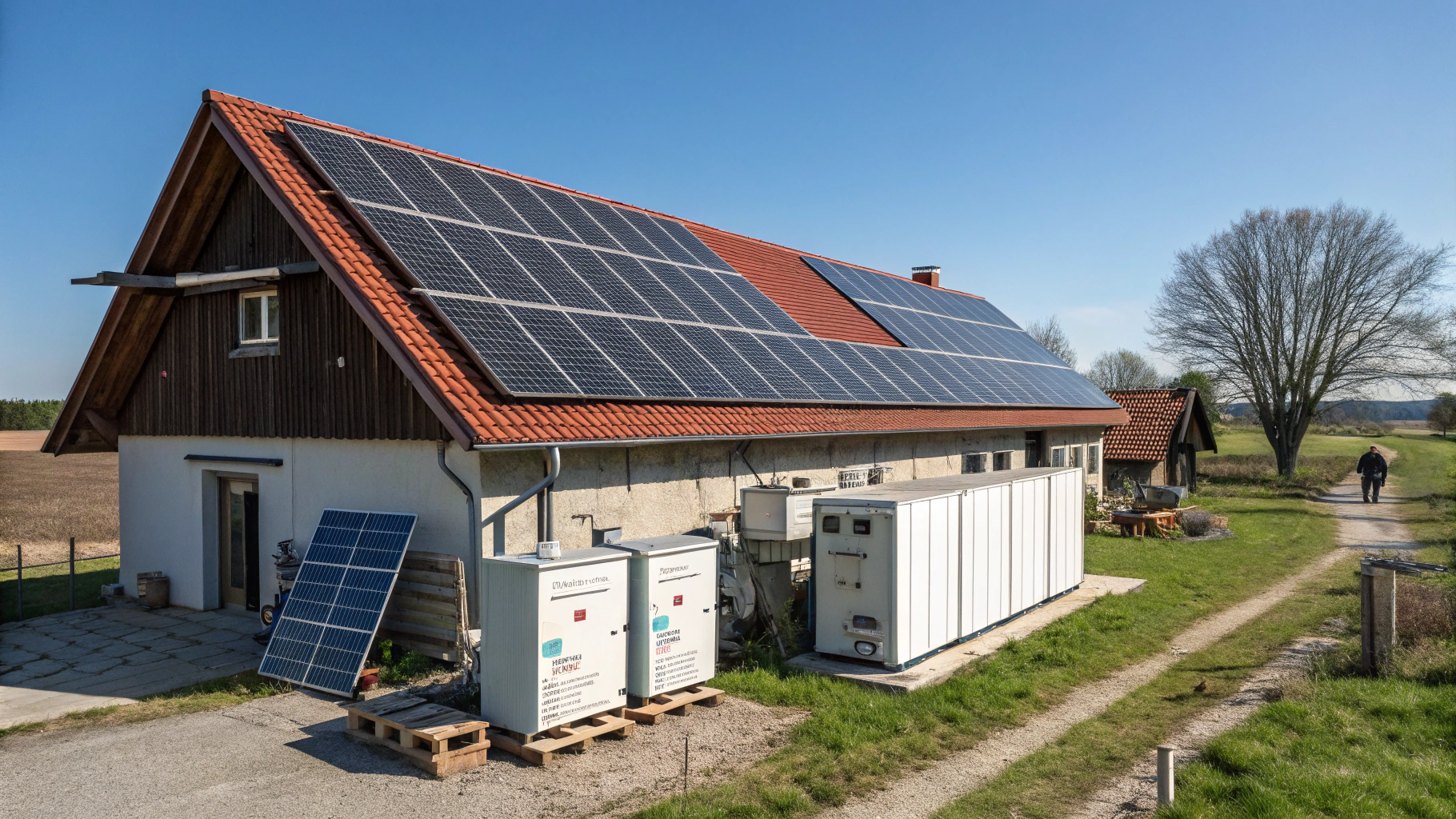
The decision to transition to solar energy marked a pivotal moment for me, and I must admit, I was particularly captivated by the allure of an off-grid solar power system. Envisioning a life where I could generate my own electricity and free myself from the constraints of the traditional power grid was an irresistible proposition. Yet, as I delved into the intricacies of off-grid versus on-grid solar systems, I found the landscape to be somewhat daunting. Allow me to share the insights gleaned from my journey.
Off-grid solar power systems operate entirely independent of conventional electrical grids, relying solely on solar panels and batteries for energy storage, in stark contrast to on-grid systems that maintain a connection for an ongoing electricity supply.
What draws many, including myself, to off-grid systems is the unparalleled independence they offer. These systems harness solar panels to collect energy, storing it through batteries for use when the sun isn’t shining. However, it’s essential to acknowledge that this autonomy comes at a price—literally. The initial investment is often steeper due to the necessity for substantial battery banks and inverters, in addition to the requirement for ongoing maintenance. Conversely, on-grid systems present a more economical choice, seamlessly integrating with the main grid to provide a constant power supply. They eliminate the need for batteries, simplifying maintenance requirements, yet this convenience is coupled with a reliance on the stability of the grid.
If you find yourself weighing the benefits of each system, I encourage you to reflect on key factors such as your aspiration for energy self-sufficiency, your budget for initial investments, and the reliability of your local power grid. Personally, the allure of an off-grid lifestyle was too compelling to ignore, even with the higher upfront costs. It represented not merely a shift towards energy independence but a significant step toward a more sustainable and self-reliant future. I urge you to explore these alternatives for yourself; you may discover, as I did, that this endeavor is indeed a rewarding path worth pursuing.
Understanding the Differences Between Off-Grid and On-Grid Solar Energy Systems
Throughout my journey into the world of solar energy, I was fascinated to learn how off-grid solar systems operate independently from conventional grids through solar panels and batteries, while on-grid systems maintain a connection for a stable electricity supply. This distinction allowed me to understand the importance of considering energy self-sufficiency versus reliance on the grid.
| Feature | Off-Grid Solar | On-Grid Solar |
|---|---|---|
| Independence | Operates independently of the grid | Connected to the main power grid |
| Energy Storage | Requires batteries for storage | No batteries needed, uses grid backup |
| Initial Cost | Higher upfront investment | Lower initial setup costs |
| Maintenance | Requires ongoing maintenance for batteries | Less maintenance required |
| Energy Self-Sufficiency | Provides complete energy independence | Dependent on grid stability |
Off-grid solar systems rely on ongoing electricity supply from the grid.False
Off-grid systems function independently and do not connect to the grid.
Off-grid solar systems use batteries for energy storage when solar is insufficient.True
These systems store energy in batteries for use during non-sunny periods.
Comparison of Connection Methods
Examining connection methodologies uncovers a plethora of options—from steadfast wired links to the dynamic allure of wireless connections. The discourse surrounding wired versus wireless connectivity remains ever-relevant. When considering home and office configurations, each method presents distinct advantages; while wired infrastructures boast reliability, wireless systems exude adaptability. Delving into the intricacies of smart device networking highlights the necessity for stringent protocols. Ultimately, discerning the nuances of connection types empowers users to make informed, tailored decisions for their unique requirements.
Use Case Scenarios and Economic Impacts
In the ever-evolving landscape of commerce, grasping use case scenarios is essential for enterprises aiming to maximize their economic influence. Through diligent use case scrutiny and astute scenario forecasting, corporations unlock economic ramifications that refine their decision-making process. Diverse industrial examples highlight a spectrum of financial advantages, with pragmatic applications propelling monetary expansion. By leveraging advanced economic analysis methodologies, firms undertake thorough financial impact assessments. Melding economic modeling with forecast techniques, they unveil prevailing trends, guaranteeing accurate impact evaluations. Ultimately, a well-executed cost-benefit analysis empowers organizations, fostering resilient economic frameworks for enduring prosperity.
Government Incentives and Policies
In the intricate labyrinth of governmental incentives and policies lies a bountiful terrain brimming with potential for enterprises. The landscape spans a tapestry of tax breaks, subsidy initiatives, and grants, creating an expansive canvas of financial support. Local and state regulations frequently converge, promoting revitalization schemes alongside eco-friendly development frameworks. Regulatory incentives play a crucial role in steering economic stimulus efforts, whilst tactical public policy incentives enhance economic growth strategies. Delving into federal initiatives, in conjunction with public sector advantages, reveals transformative opportunities for small businesses, catalyzing economic advancement within a strategically governed milieu.
Conclusion
In conclusion, embracing off-grid solar power systems opens up a world of energy independence and sustainability. By understanding the fundamental components—solar panels, charge controllers, battery banks, and inverters—you can take meaningful steps toward a greener lifestyle. These systems not only liberate you from the conventional electricity grid but also empower you to reduce your carbon footprint significantly.
As you explore the benefits of off-grid living, I encourage you to consider how this transformational journey aligns with your aspirations for self-sufficiency and environmental stewardship. Start your exploration today, delve deeper into the available options, and take that bold step toward achieving a sustainable future powered by clean, renewable energy.


